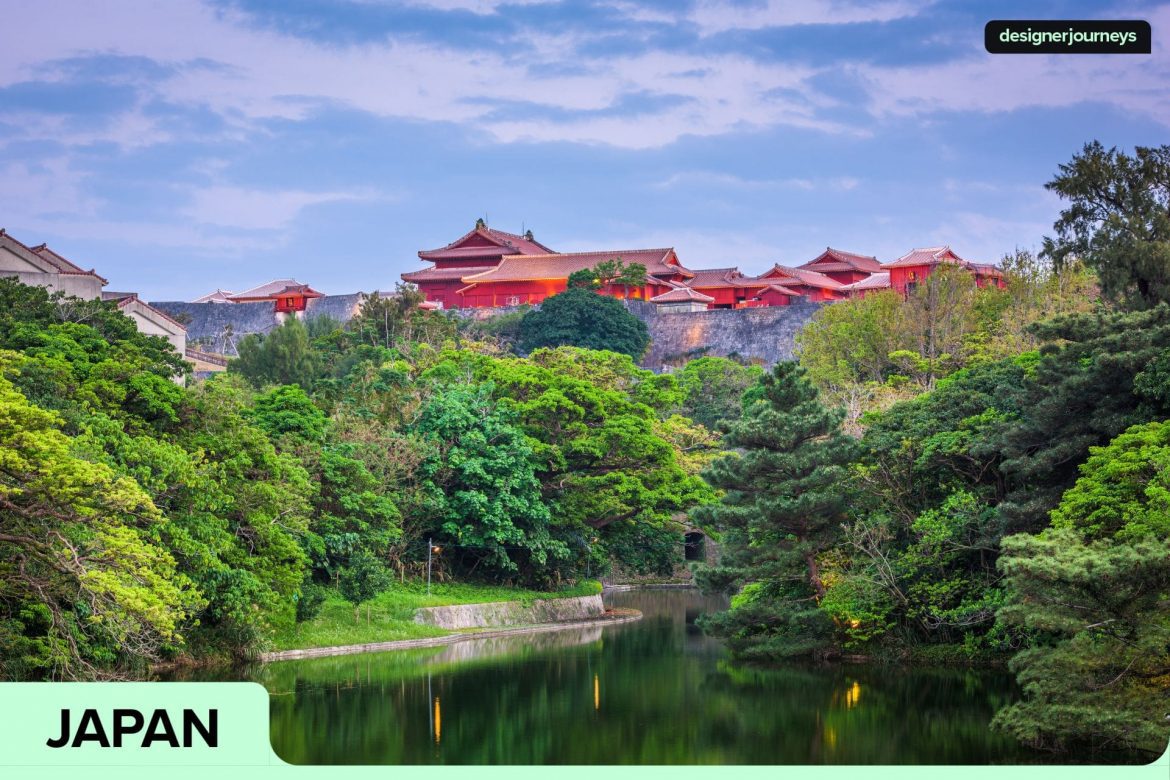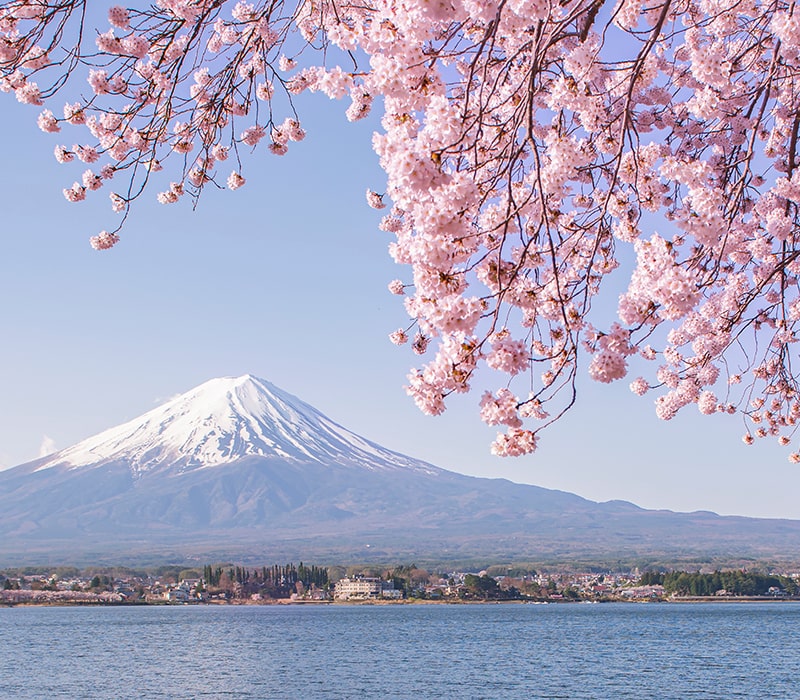Picture an island chain where emerald seas sparkle beneath a starry sky, coral reefs shelter gentle sea turtles and majestic whale sharks, and the echoes of the Ryukyu kings still linger in ancient castle ruins. This is Okinawa, a world apart from mainland Japan, where vibrant Okinawan culture, tropical landscapes, and crystal clear waters create an unforgettable blend of adventure and tradition. From exploring Shuri Castle and wandering along Kokusai Street in Naha City, to diving in the Blue Cave, relaxing on the pristine beaches of Miyako and Ishigaki, or savouring iconic Okinawan cuisine like taco rice, soba, and bitter melon, every corner of this archipelago invites discovery. In this guide, you’ll find expert tips, must-see attractions, and hidden gems to help you plan a seamless Okinawa adventure, from Okinawa Honto’s bustling energy to the tranquil charm of its southern islands. Let’s dive in with Designer Journeys!
Post Contents
- Understanding Okinawa’s Unique Identity
- Discovering the Heritage of the Former Ryukyu Kingdom
- Immersing Yourself in Okinawan Culture
- Island-Hopping: Discovering Okinawa’s Beautiful Outlying Islands
- Must-Visit Tourist Attractions on the Main Island
- Savouring Okinawan Cuisine
- Best Times to Visit Okinawa
- F.A.Qs
- Your Okinawa Adventure Awaits
Understanding Okinawa’s Unique Identity
Before setting foot on Okinawan soil, it’s essential to discover what makes this destination truly special. Okinawa is not simply another Japanese prefecture; it’s a place where distinct traditions, language, and cultural identity have flourished for centuries. The islands were once the independent Ryukyu Kingdom, a prosperous maritime nation that traded with China, Southeast Asia, and Japan from the 15th to 19th centuries. This unique position created a cultural melting pot that remains evident today in Okinawan architecture, cuisine, customs, and arts, making Okinawa a place to see and experience distinctly different from mainland Japan.
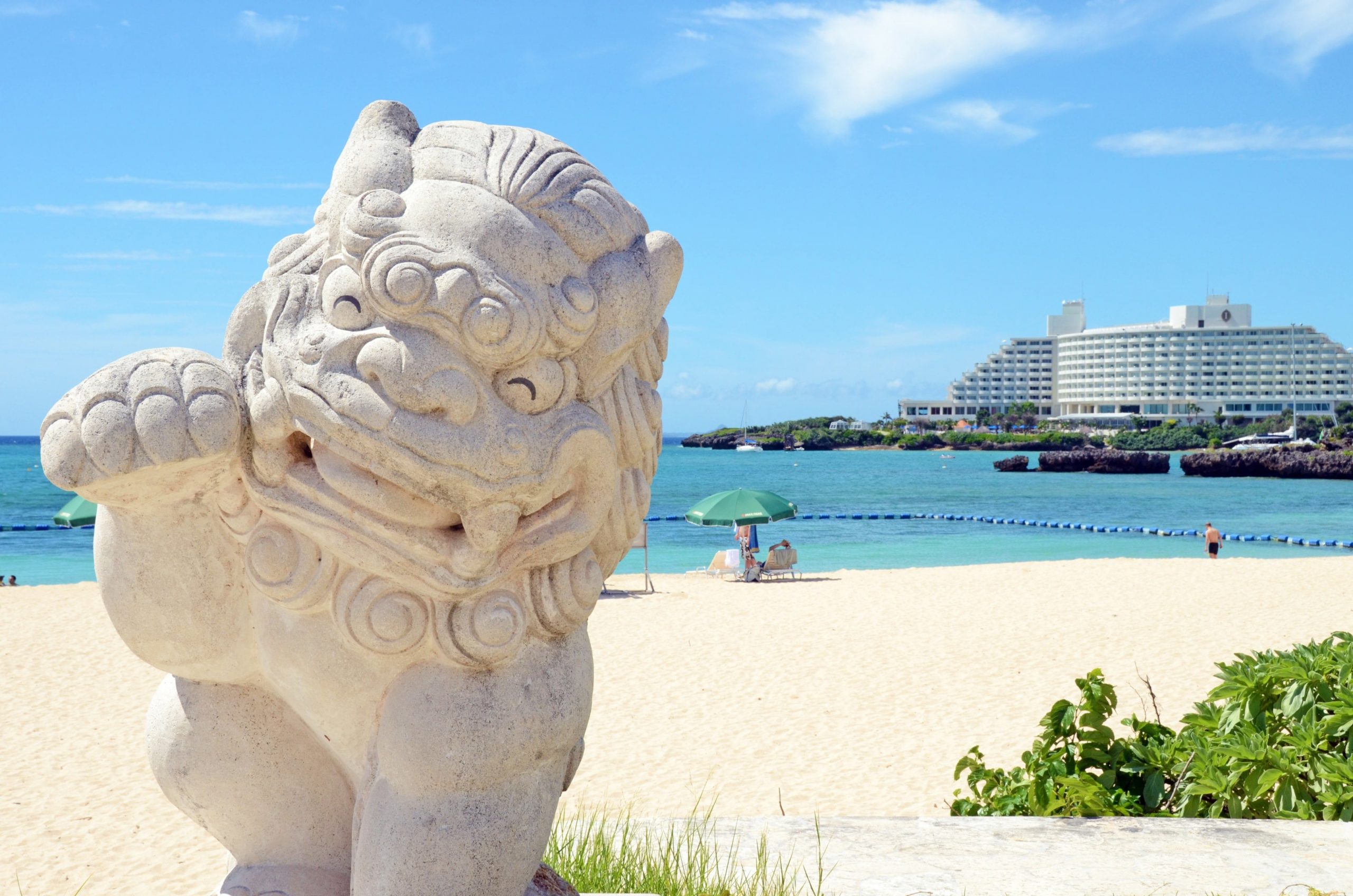
Okinawa Prefecture is Japan’s southernmost prefecture, an archipelago of islands.
The Ryukyu kings ruled from magnificent castles adorned with distinctive architecture influenced by Chinese and Japanese design. While World War II and subsequent events damaged many of these treasures, restoration work continues to preserve this heritage for future generations. When visiting Okinawa, you’re not just exploring Japan—you’re discovering a culture with its own language, traditions, and worldview that persists proudly alongside modern Japanese identity.
Discovering the Heritage of the Former Ryukyu Kingdom
Shuri Castle: The Crown Jewel of Ryukyu Architecture
No visit to Okinawa is complete without exploring Shuri Castle, the symbolic heart of the Ryukyu Kingdom and once home to the Ryukyu kings. Perched atop a hill in Naha city, this magnificent complex served as the political, economic, and cultural centre of the kingdom for approximately 450 years. The castle’s distinctive vermillion buildings, featuring a unique blend of Japanese and Chinese architectural elements, create an unforgettable sight against the Okinawan sky and stand as one of the most iconic attractions in Okinawa.
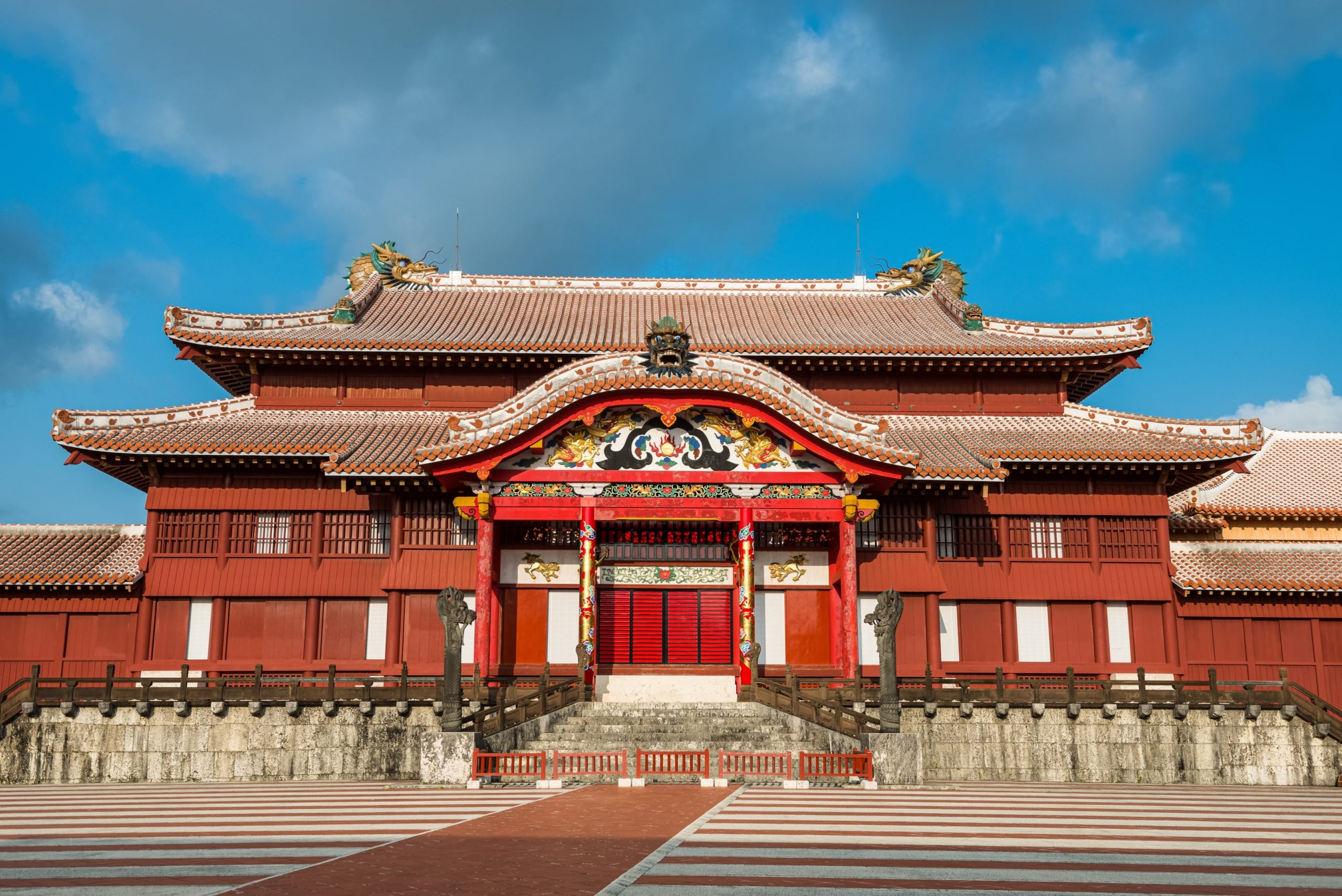
Shuri Castle has been destroyed and rebuilt multiple times throughout its history.
While a devastating fire in 2019 destroyed several main structures, restoration work is actively underway, demonstrating Okinawa’s commitment to preserving its heritage. Even during reconstruction, many visitors continue to explore the grounds, learn about restoration efforts, and discover the castle’s fascinating history through exhibits and guided tours. The Shureimon Gate, one of the most photographed landmarks when visiting Okinawa, stands as a testament to the kingdom’s former glory and serves as an iconic symbol of Okinawan culture.
Practical Information:
- Location: Naha City, easily accessible from Naha Airport
- Best visited in the morning to avoid crowds and heat
- Admission fees apply; combination tickets available with other sites
- Allow 2-3 hours for a thorough exploration
Nakagusuku Castle: A Stone Testament to Ryukyu Engineering
For those seeking a more intimate encounter with Ryukyu history, Nakagusuku Castle offers stunning views and remarkable architectural achievement. This UNESCO World Heritage site showcases the sophisticated stone masonry techniques perfected by Ryukyu builders and represents one of the fun things to do in Okinawa for history enthusiasts. The castle’s walls curve gracefully across a hilltop, demonstrating both defensive strategy and aesthetic sensibility.
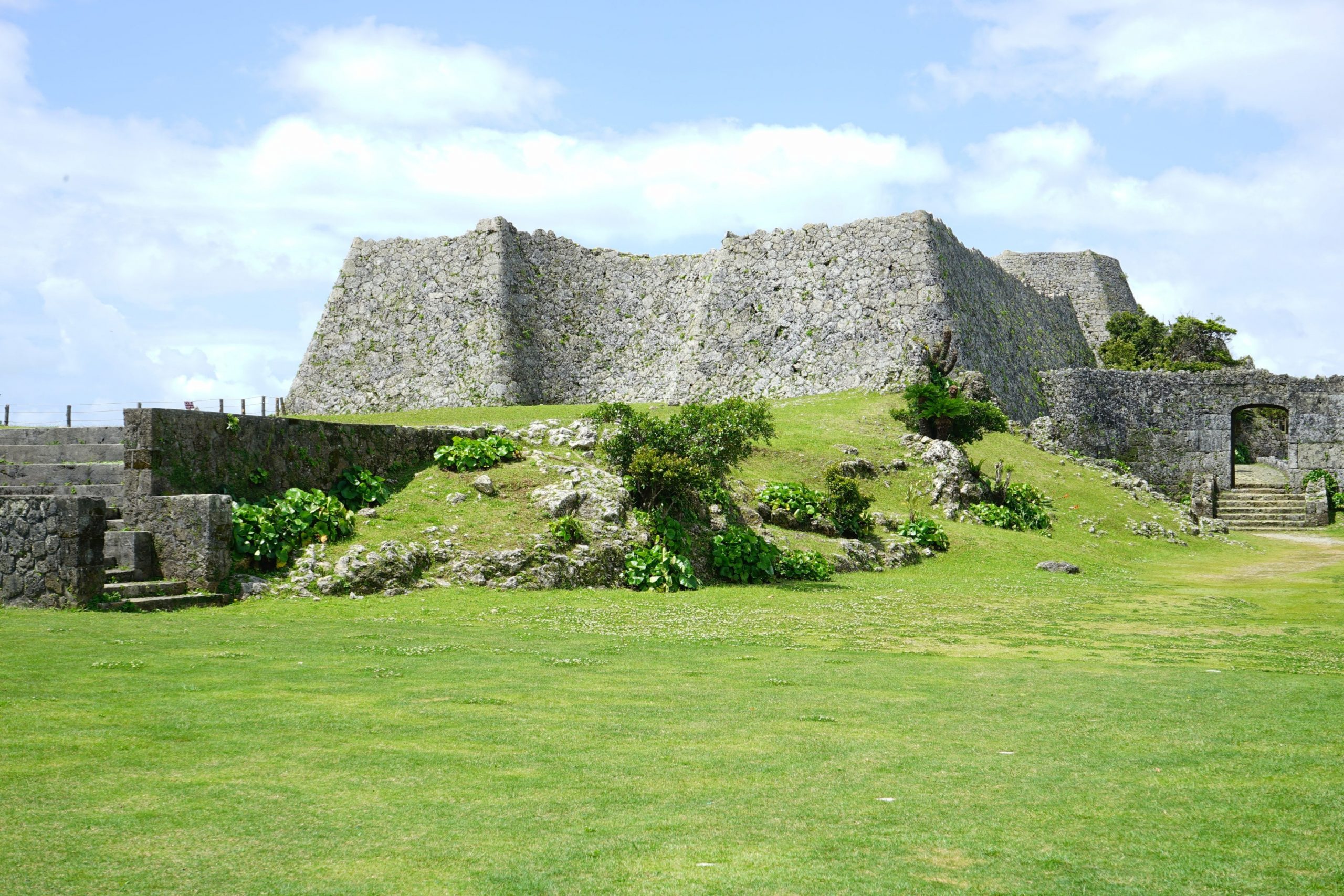
The castle is known for its impressive, curving stone walls that were built without mortar.
Nakagusuku Castle tells stories of political intrigue, strategic military planning, and the artistic vision that characterised the Ryukyu Kingdom at its height. Walking along the ancient walls, you can imagine the lords who once commanded this fortress and the role it played in the kingdom’s complex history. The site remains less crowded than Shuri Castle, offering opportunities for quiet reflection and photography without the press of many visitors.
Practical Information:
- Located in central Okinawa, approximately 30 minutes by rental car from Naha
- Modest admission fee
- Wear comfortable walking shoes for exploring the stone pathways
- Sunset visits offer particularly dramatic lighting for photography
Immersing Yourself in Okinawan Culture
Okinawa Prefectural Museum: Gateway to Understanding
Before diving deeper into your Okinawa trip, consider visiting the Okinawa Prefectural Museum in Naha City. This modern facility provides comprehensive insight into Okinawan culture, history, and natural environment through engaging exhibits. The museum showcases everything from the geology and ecology of the islands to detailed presentations on the Ryukyu Kingdom, traditional crafts, and contemporary Okinawan society.
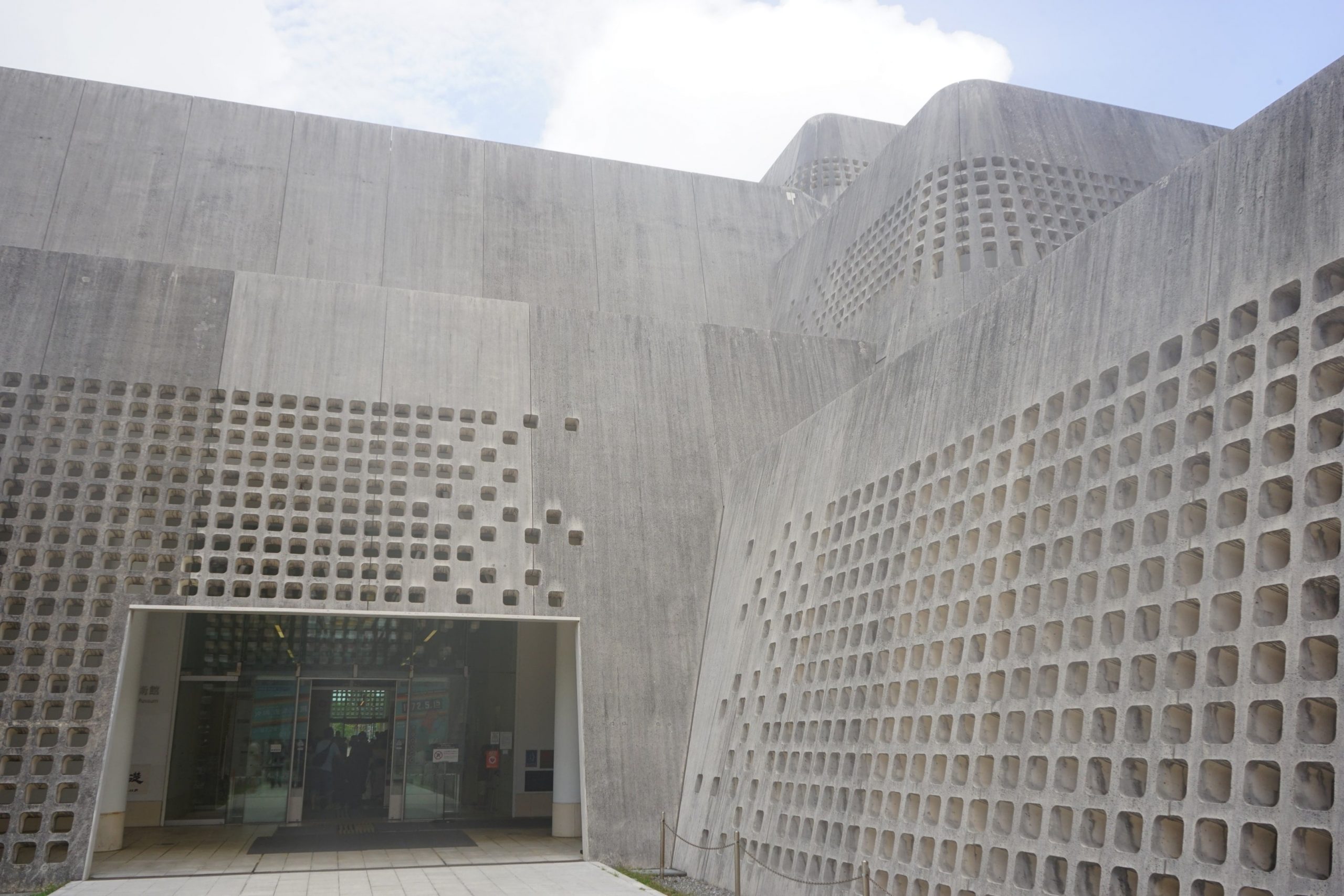
It is located in the Omoro-machi area of Naha, easily accessible via the Okinawa Urban Monorail.
The museum’s art section features both historical and contemporary works, including beautiful examples of Ryukyu textiles, paintings, and pottery. For those seeking to understand the context of their experiences throughout the islands, the Okinawa Prefectural Museum offers valuable background that enriches all subsequent encounters with Okinawan culture. The exhibits are well-presented with English explanations, making it accessible for international visitors planning their Okinawa things to do list.
Practical Information:
- Located in Naha city, accessible by monorail
- Admission: Adults ¥410 (museum), ¥530 (combined museum and art museum)
- Allow 2-3 hours for thorough exploration
- Closed on Mondays
Cultural Theme Parks and Living History
Okinawa World offers a comprehensive introduction to Okinawan culture through a well-crafted theme park experience, making it one of the most popular tourist attractions on the main island. This attraction combines natural wonders with cultural demonstrations, featuring the Gyokusendo Cave system, one of the most impressive limestone cave networks in Japan, alongside traditional craft workshops, performances, and a reconstructed Ryukyu village.
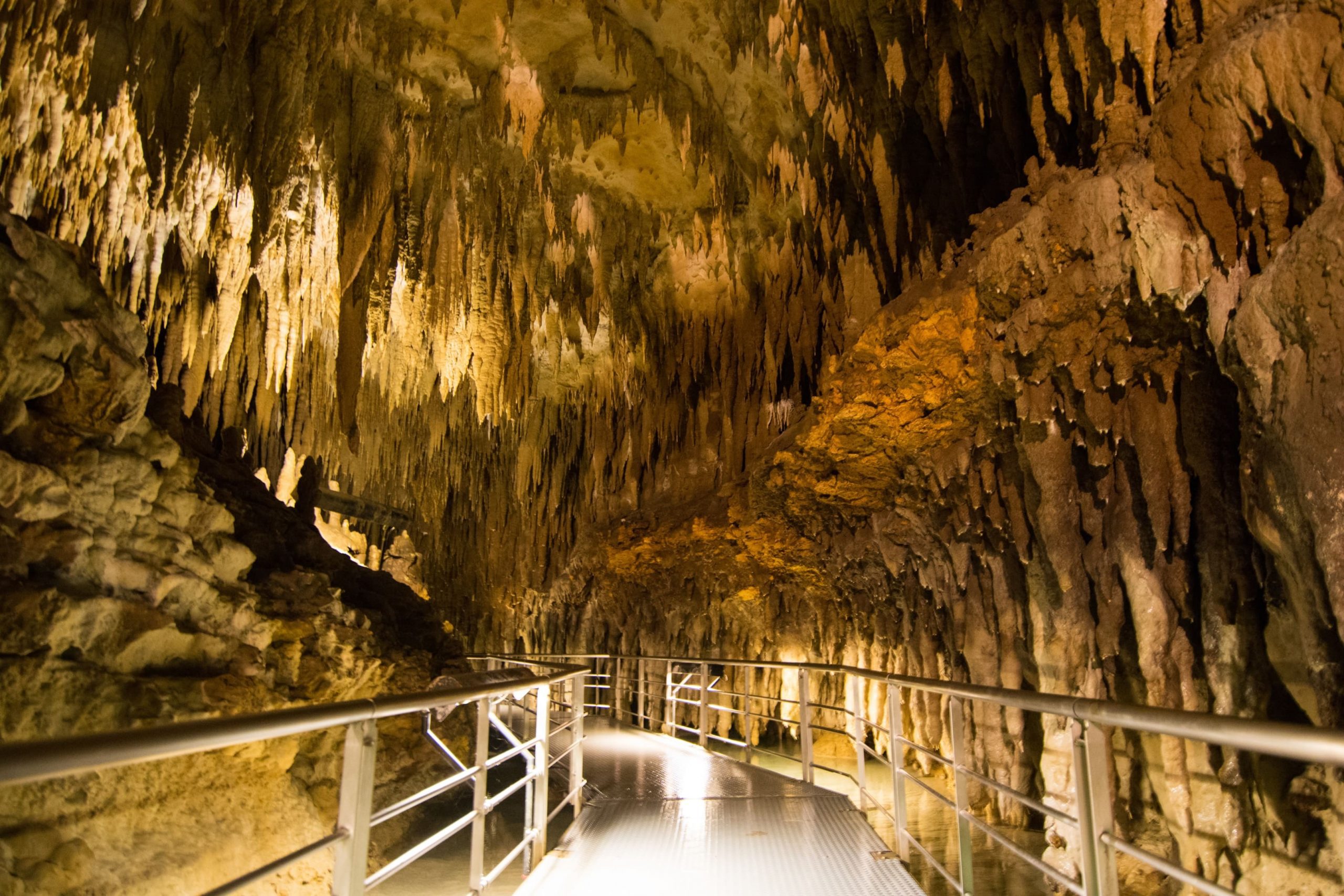
The park is located in the southern part of Okinawa Island.
The limestone cave alone justifies a visit, with its vast chambers adorned with spectacular stalactites and stalagmites formed over hundreds of thousands of years. Above ground, you can watch craftspeople create traditional textiles, pottery, and other crafts while learning about the techniques and cultural significance of each art form. Traditional Eisa dance performances showcase the energetic folk dance style unique to Okinawa, with powerful drumming and acrobatic movements that captivate audiences.
Practical Information:
- Located in southern Okinawa, approximately 30-40 minutes from Naha by rental car
- Full-day attraction; arrive early to experience everything
- Admission packages available with various combinations of attractions
- The southern tip of the main island offers several attractions; consider combining Okinawa World with nearby castle visits
Island-Hopping: Discovering Okinawa’s Beautiful Outlying Islands
While the Okinawa main island offers abundant attractions, Okinawa’s outlying islands provide some of the most memorable experiences available for your trip. Each island possesses distinct character and attractions, from the crystalline waters of Miyako to the untamed jungles of Iriomote. Island-hopping allows you to design a journey that encompasses different facets of Okinawan island life, creating a varied and enriching travel experience.
Miyako Island: Pristine Beaches and Luxury Relaxation
Miyako Island has earned recognition as home to some of Japan’s most beautiful beaches, making it one of the most beautiful islands to include in your Okinawa trip. Yonaha Maehama Beach stretches for seven kilometres of powder-fine white sand meeting impossibly clear turquoise waters. The beach’s gentle slope and calm conditions make it perfect for swimming, while the stunning views provide the postcard-perfect tropical scenery that many visitors envision when planning things to do in Okinawa.
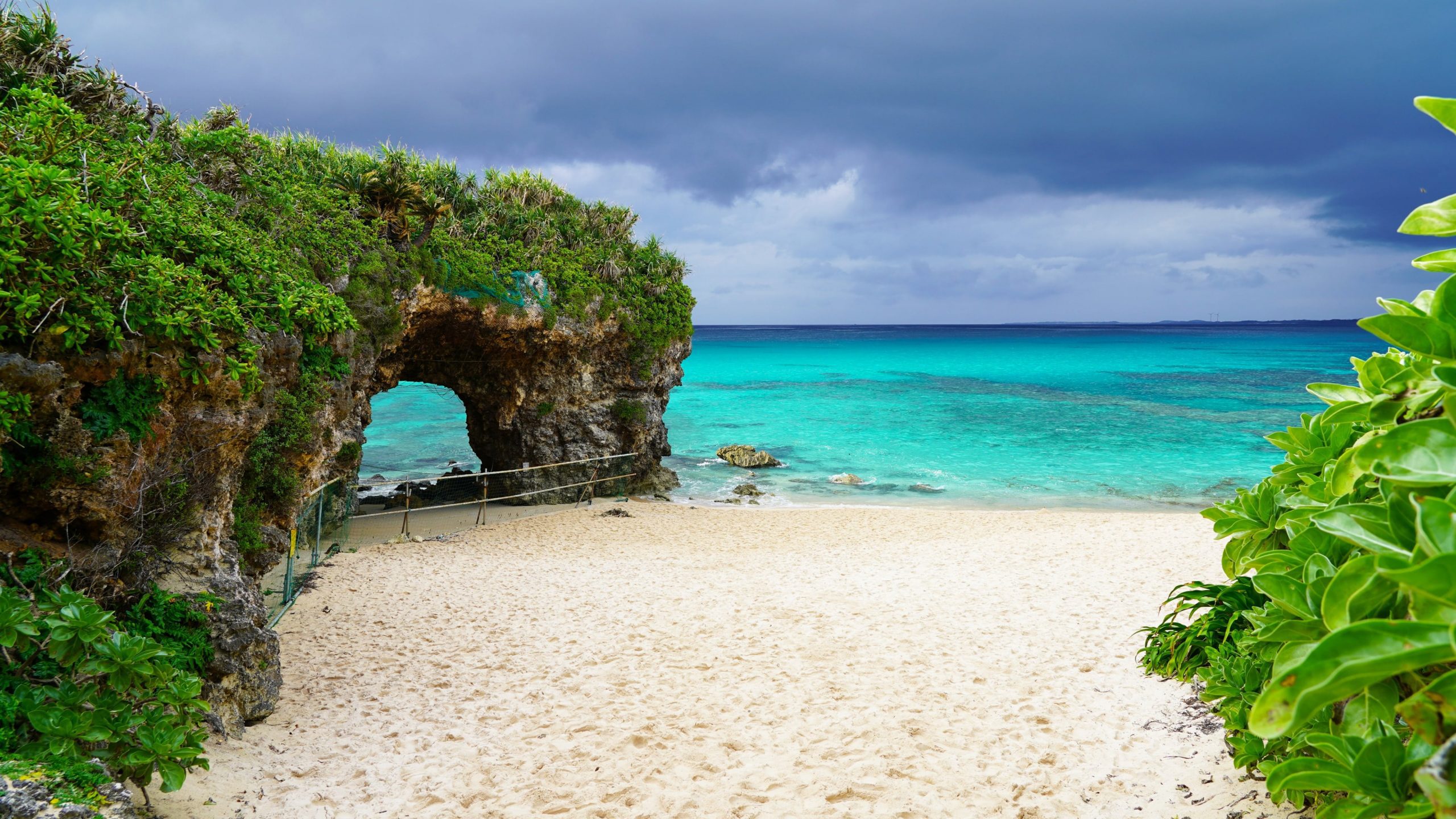
The island’s surrounding waters provide a rich bounty of fresh seafood.
Beyond the beaches, Miyako Island offers excellent scuba diving and snorkelling, with healthy coral reefs and abundant marine life, including sea turtles and colourful tropical fish. The island’s compact size makes it easy to explore by rental car, and the relaxed pace of life here provides a welcome respite from busier tourist attractions. Several luxury resorts have established themselves on Miyako, offering high-end accommodations and seamless service in spectacular settings with crystal clear waters at your doorstep.
Practical Information:
- Accessible by direct flight from Naha Airport (approximately 50 minutes)
- Several day trip options available, though overnight stays allow for more relaxed exploration
- Peak season (summer) can be crowded; consider shoulder seasons for quieter experiences
Ishigaki Island: Gateway to the Yaeyama Islands
Ishigaki Island serves as the gateway to the Yaeyama Islands, the southernmost region of Okinawa and one of the most spectacular areas for visiting Okinawa’s outlying islands. The island combines accessibility with natural beauty, featuring excellent beaches, scuba diving opportunities, and cultural attractions. Kabira Bay, with its emerald waters and scenic offshore islets, ranks among Okinawa’s most photographed locations and stands as one of the premier Okinawa attractions. While swimming is prohibited to protect the bay’s delicate ecosystem, glass-bottom boat tours allow you to appreciate Kabira Bay’s renowned beauty and observe the pearl cultivation that occurs in these pristine waters.
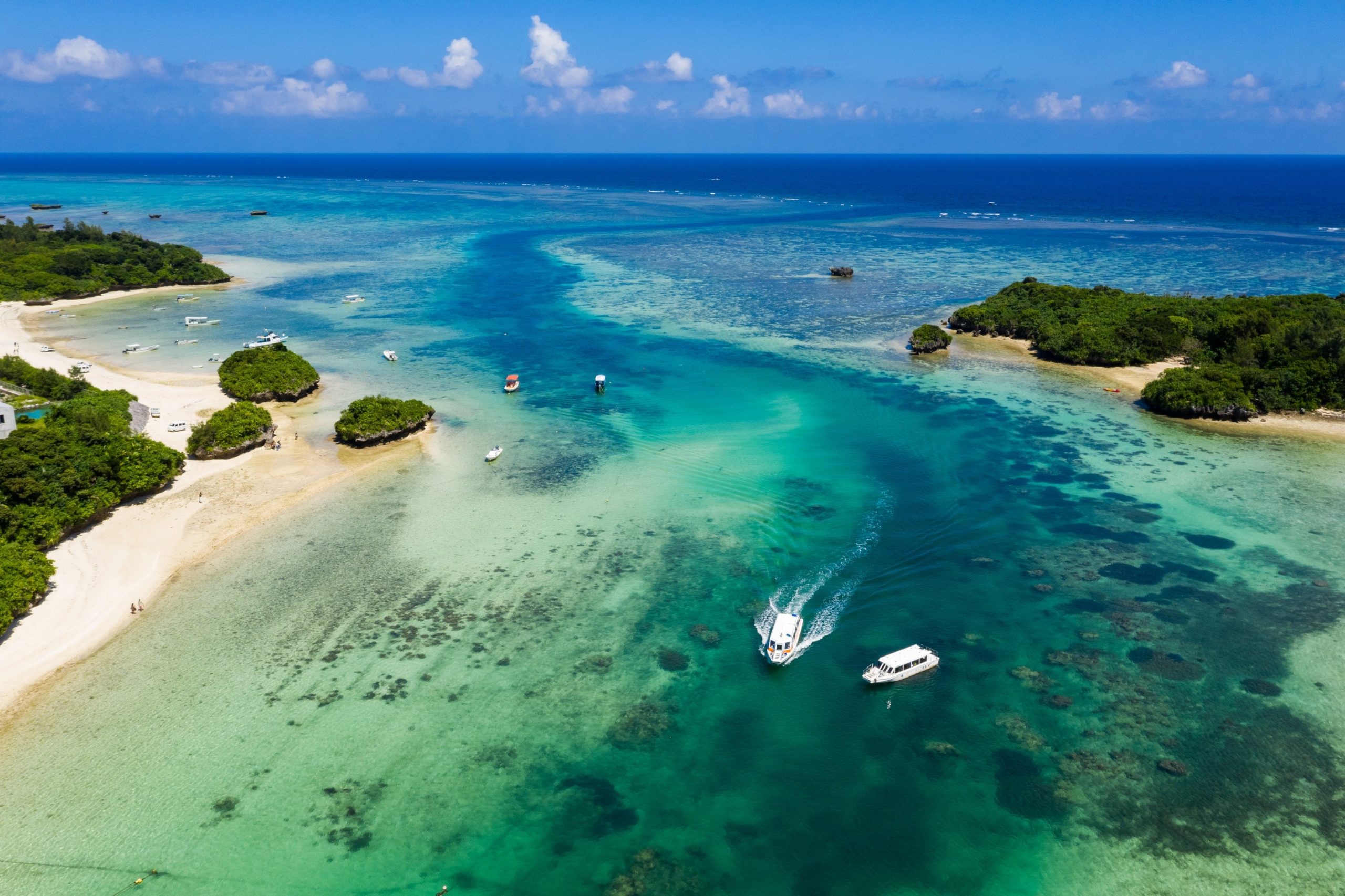
Considered one of Japan’s most scenic spots, famous for its emerald-green water and white sand.
Ishigaki offers sophisticated infrastructure with numerous hotels, restaurants, and tour operators, making it an ideal base for exploring the surrounding beautiful islands. The island’s downtown area provides shopping and dining options, while the coastline offers beaches and outdoor activities. From Ishigaki, ferry connections make day trip adventures to nearby islands both convenient and rewarding, including easy access to both Ishigaki and Iriomote Islands for comprehensive exploration.
Practical Information:
- Direct flights from Naha Airport (approximately 60 minutes)
- Well-developed tourism infrastructure with English-speaking services
- The ferry terminal provides connections to Taketomi, Iriomote, and other Yaeyama islands
Iriomote Island: Untamed Jungle Adventure
Iriomote Island offers the most dramatic contrast to Okinawa’s beach-focused attractions, making it one of the most unique Okinawa things to experience for adventure seekers. Approximately 90% of the island remains covered in dense subtropical jungle, creating a wild landscape where waterfalls cascade through pristine forests and rare wildlife thrives. The island’s interior remains largely inaccessible, but guided tours along rivers penetrating the jungle provide unforgettable outdoor activities.
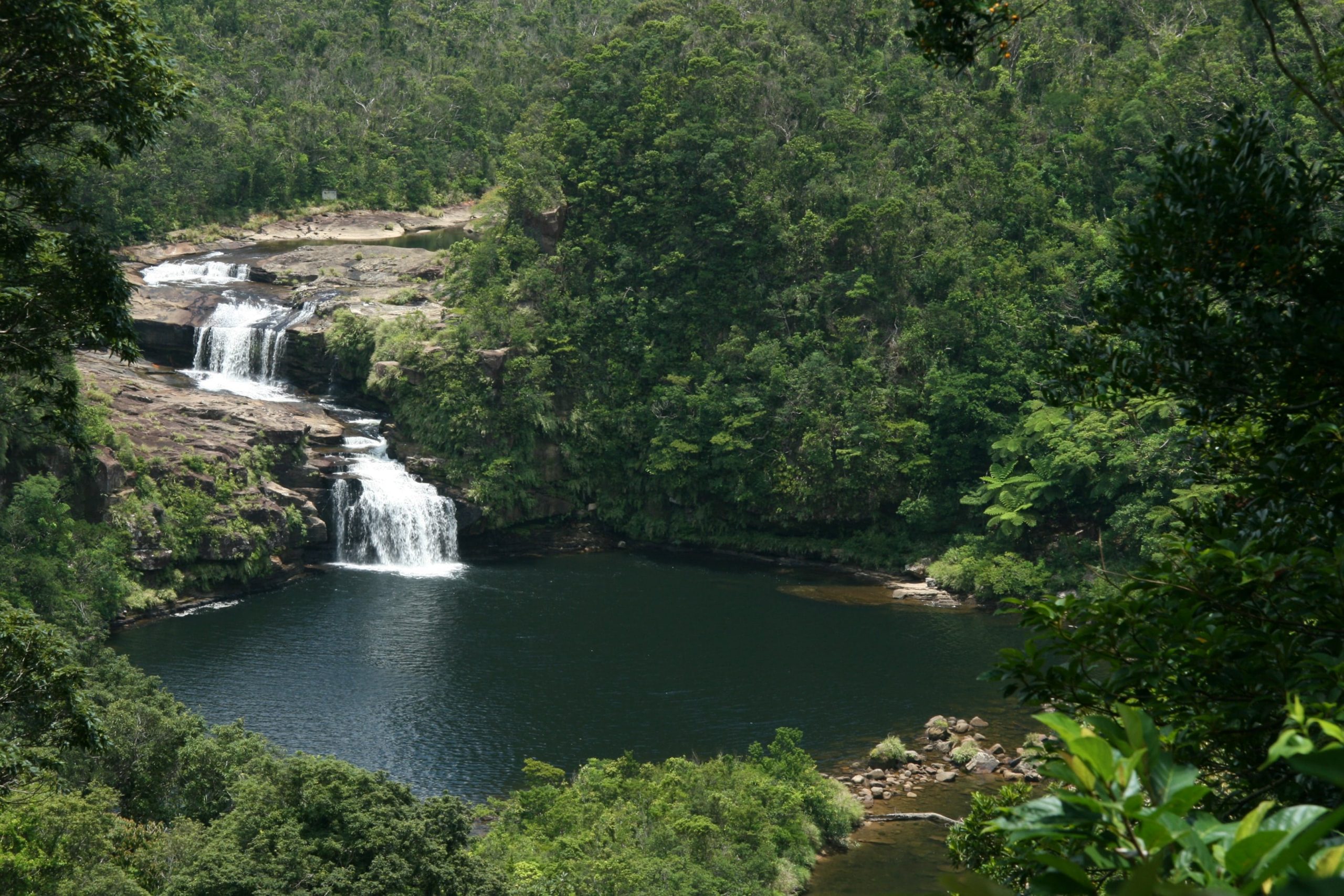
The island is the only natural habitat of the critically endangered Iriomote wildcat, a nocturnal wildcat.
The Iriomote wildcat, a critically endangered species found nowhere else on Earth, symbolises the island’s ecological importance. While sightings are extremely rare, knowing that these mysterious felines inhabit the surrounding jungle adds excitement to any Iriomote exploration. The island’s mangrove forests, waterfalls, and hiking trails offer outdoor activities for adventurous travellers seeking experiences beyond typical beach holidays when visiting Okinawa.
Practical Information:
- Accessible by ferry from Ishigaki Island (40-50 minutes)
- Limited accommodation options; consider day trip from Ishigaki
- Guided tours are recommended for jungle activities
- Book tours in advance, especially for kayaking and canyoning experiences
Taketomi Island: Traditional Village Charm
Just a short ferry ride from Ishigaki, Taketomi Island preserves traditional Okinawan village life with remarkable authenticity, offering one of the most culturally immersive experiences among the outlying islands. Red-tile-roofed houses line narrow streets paved with white coral sand, with stone walls and tropical flowers creating picture-perfect scenes. The island’s small size makes it ideal for exploration by bicycle or traditional water buffalo cart, providing relaxed immersion in old Okinawa—a refreshing contrast to busier tourist attractions.
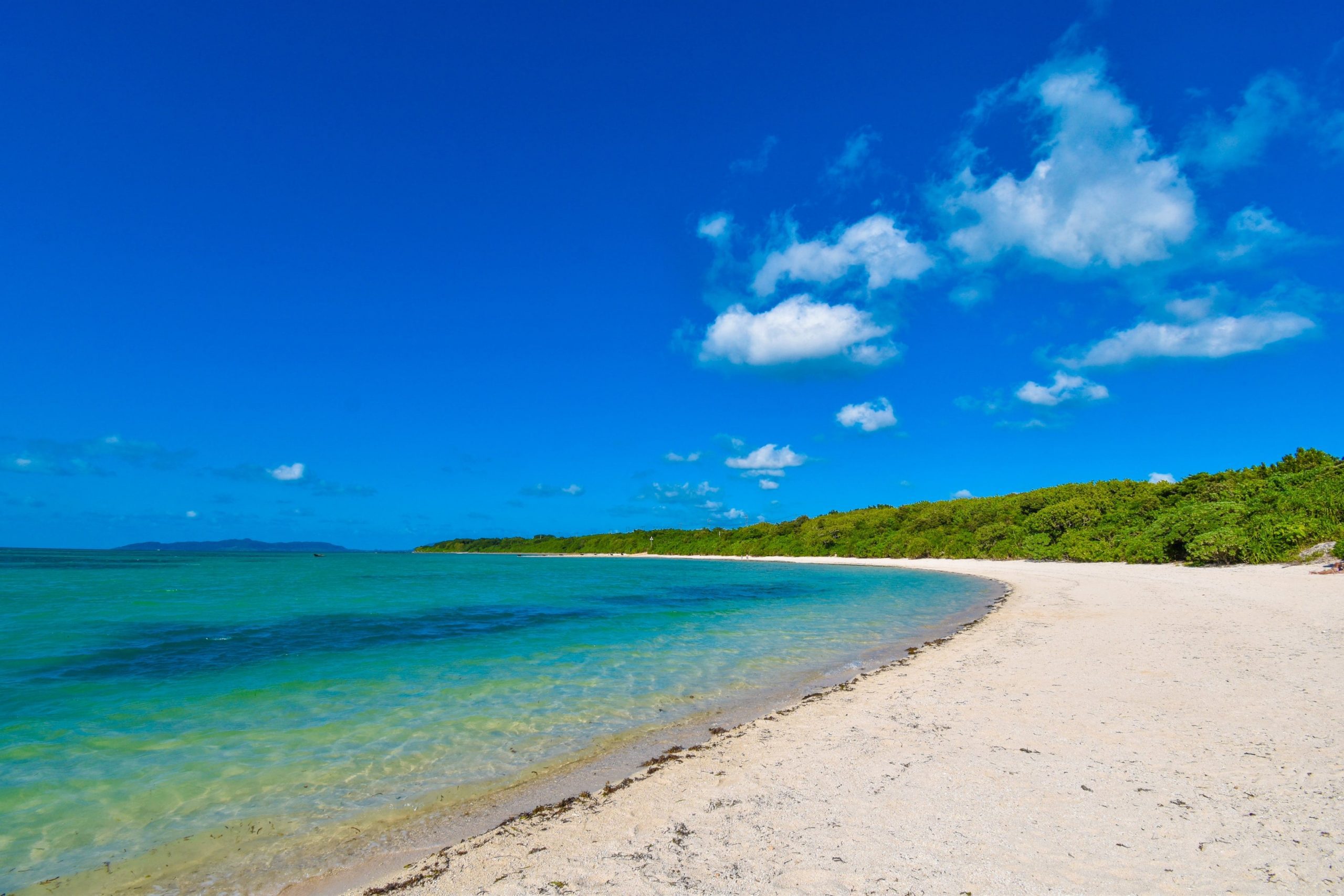
Known for its shallow, crystal-clear water, this beach is perfect for swimming and relaxing.
Taketomi’s beaches, particularly Kondoi Beach, offer beautiful swimming and snorkelling without the development found on larger islands. The pace of life here moves slowly, encouraging visitors to unwind and appreciate simple pleasures, the play of light on coral walls, the sound of wind through palm fronds, and the warmth of local hospitality. For those seeking authentic cultural experiences and peaceful relaxation during their Okinawa trip, Taketomi provides both in abundance.
Practical Information:
- Ferry from Ishigaki (10-15 minutes)
- No cars on the island; bicycles available for rent
- Day trips from Ishigaki are common
- Small islandcan be explored easily in half a day, though longer stays offer a deeper appreciation
Kerama Islands: Diving Paradise Near Naha
The Kerama Islands, including Tokashiki Island and Zamami Island, lie just 30-40 kilometres west of Naha, making them accessible for day trip adventures from the main island. These islands have earned international recognition among divers for their exceptional underwater visibility, healthy coral reefs, and abundant marine life, including sea turtles and manta rays. The crystal clear waters around the Keramas are protected as a national park, ensuring the preservation of these precious marine ecosystems.
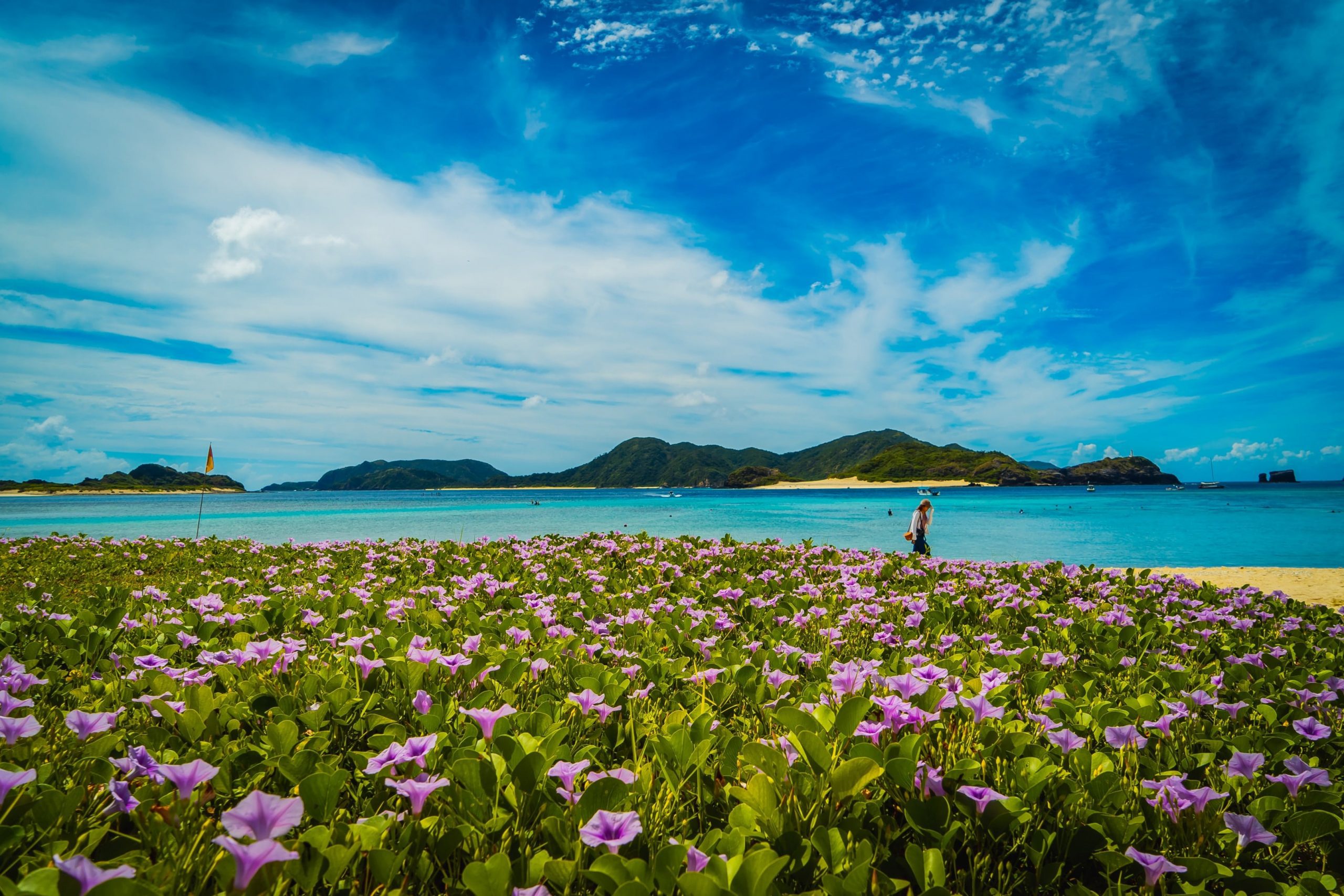
The main inhabited islands are Tokashiki, Zamami, Akajima, and Gerumajima.
Tokashiki Island features several excellent beaches, including Aharen Beach and Tokashiku Beach, both known for crystal clear waters and superb snorkelling directly from shore. Sea turtles frequently visit these beaches to feed, providing reliable opportunities for encounters with these beloved marine creatures. The island’s small size and relaxed atmosphere make it perfect for travellers seeking natural beauty without the infrastructure of larger destinations—ideal for those looking for fun things to do in Okinawa that feel more intimate and authentic.
Practical Information:
- Ferry from Naha’s Tomari Port (50-70 minutes to Tokashiki, 90-120 minutes to Zamami)
- Day trip possible, though overnight stays are recommended for diving
- Accommodation ranges from simple guesthouses to small hotels
- Book ferries in advance during the summer season
- Ferry schedules can be affected by weather; maintain schedule flexibility
Kouri Island: Scenic Bridges and Romance
Kouri Island, located off the northern coast of the Okinawa main island, has gained popularity for its scenic beauty and the stunning bridge connecting it to the main island. The Kouri Bridge spans across turquoise waters, offering one of Okinawa’s most dramatic driving experiences and one of the most photographed attractions in Okinawa. The stunning views from the bridge, with the ocean spreading in all directions beneath you, provide memorable photo opportunities and a sense of travelling between worlds.
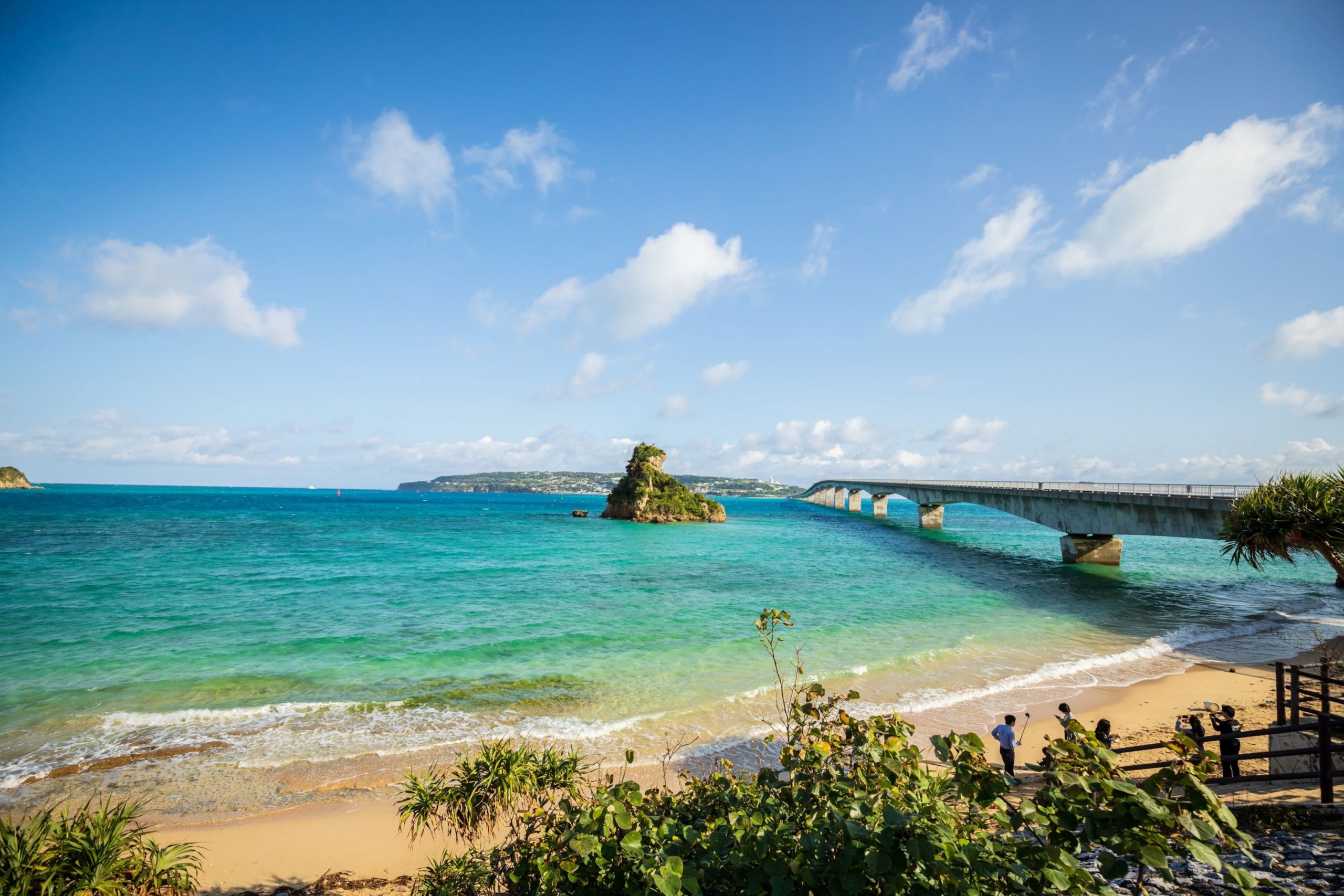
An observation tower that offers a panoramic view of the bridge and the surrounding ocean.
The island itself is small but charming, with beautiful beaches featuring crystal clear waters, casual restaurants serving fresh seafood, and the Kouri Ocean Tower offering panoramic views. Known locally as the “Island of Love” due to its legends, Kouri attracts couples seeking romantic getaways. The combination of easy accessibility (connected by bridge), natural beauty, and intimate scale makes Kouri an excellent addition to any main island itinerary when planning things to do in Okinawa.
Practical Information:
- Connected to the main island by a bridge; accessible by rental car
- Located approximately 90 minutes north of Naha
- Excellent for half-day trips combined with northern Okinawa exploration
- Popular photo spot; visit early morning to avoid crowds on the bridge
Must-Visit Tourist Attractions on the Main Island
Okinawa Churaumi Aquarium: Marine Wonders Under One Roof
The Okinawa Churaumi Aquarium ranks among Japan’s premier aquariums and stands as one of the main island’s most popular tourist attractions, drawing many visitors throughout the year. The facility’s crown jewel is the massive Kuroshio Tank, one of the world’s largest aquarium tanks, where whale sharks—the largest fish species on Earth, glide majestically alongside manta rays and countless other marine species. Standing before this enormous tank, watching these gentle giants move through the water with grace and power, creates an almost meditative experience and represents one of the most extraordinary things to do in Okinawa.
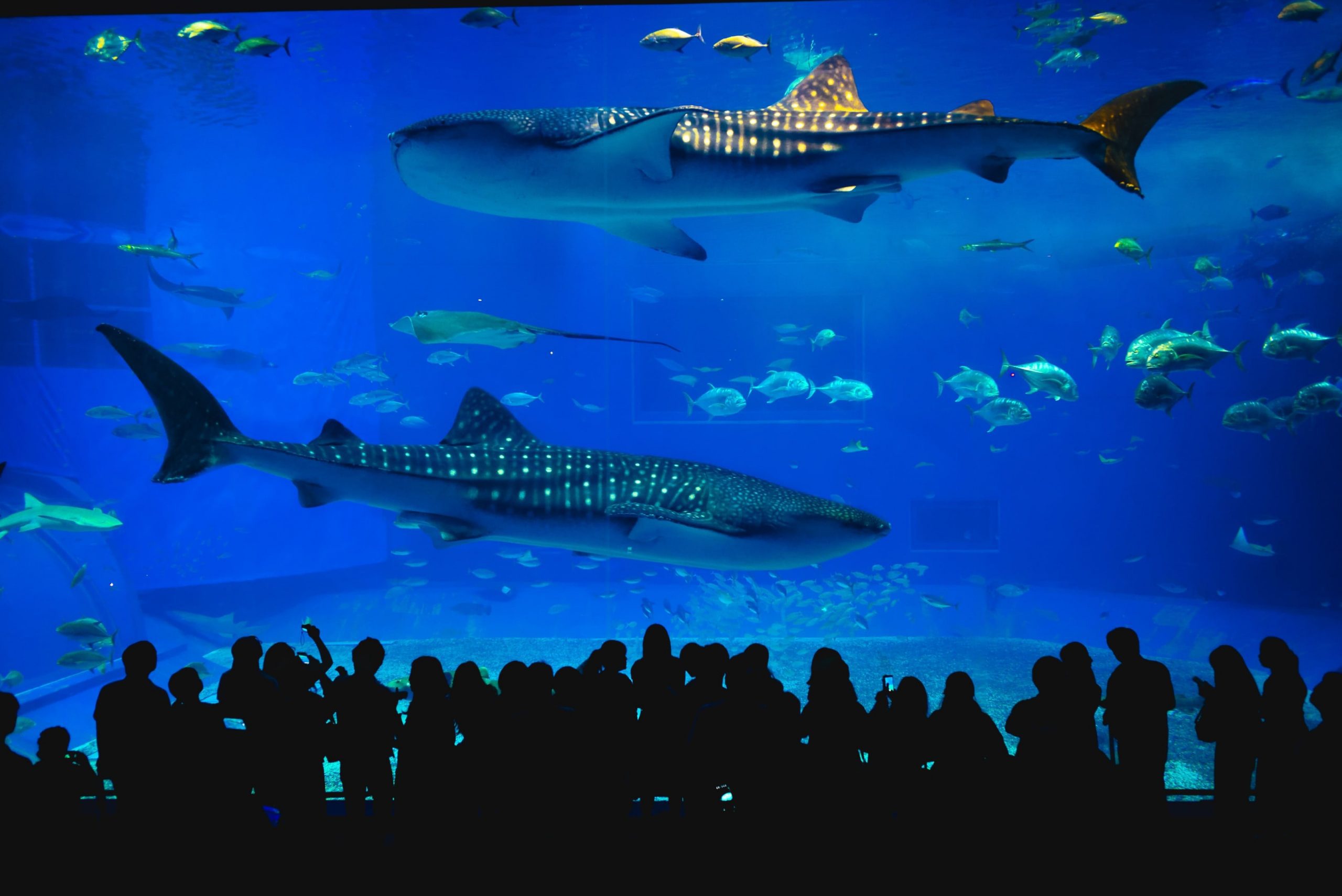
There is a “Touch Pool” where visitors can safely touch starfish and other sea creatures.
The Churaumi Aquarium showcases Okinawa’s marine biodiversity across multiple zones, from shallow coral reef ecosystems to deep-sea environments. Interactive touch pools, feeding demonstrations, and educational exhibits provide insight into marine conservation and the unique ocean environments surrounding Okinawa. The facility’s commitment to research and education ensures that your visit contributes to marine conservation efforts while providing entertainment and knowledge about the incredible marine life, including whale sharks and manta rays, that inhabit these waters.
Practical Information:
- Located in northwestern Okinawa, approximately 90 minutes from Naha by rental car
- Admission: Adults ¥2,180, advance online booking sometimes available at discount
- Very popular; arrive early or during weekday mornings to avoid peak crowds
- Ocean Expo Park admission is free; only the aquarium charges an entrance fee
- Allow 2-3 hours minimum for the aquarium, full day if exploring the entire park
American Village: Entertainment and Shopping
American Village in Chatan offers an entirely different atmosphere from traditional Okinawan culture attractions, reflecting Okinawa’s unique history and relationship with the United States. This entertainment complex features American-style shopping, dining, and entertainment in a colourful, carnival-like setting, one of the more eclectic fun things to do in Okinawa. The area comes alive in the evening, with an illuminated Ferris wheel, waterfront restaurants, and bustling crowds creating vibrant energy under the night sky.
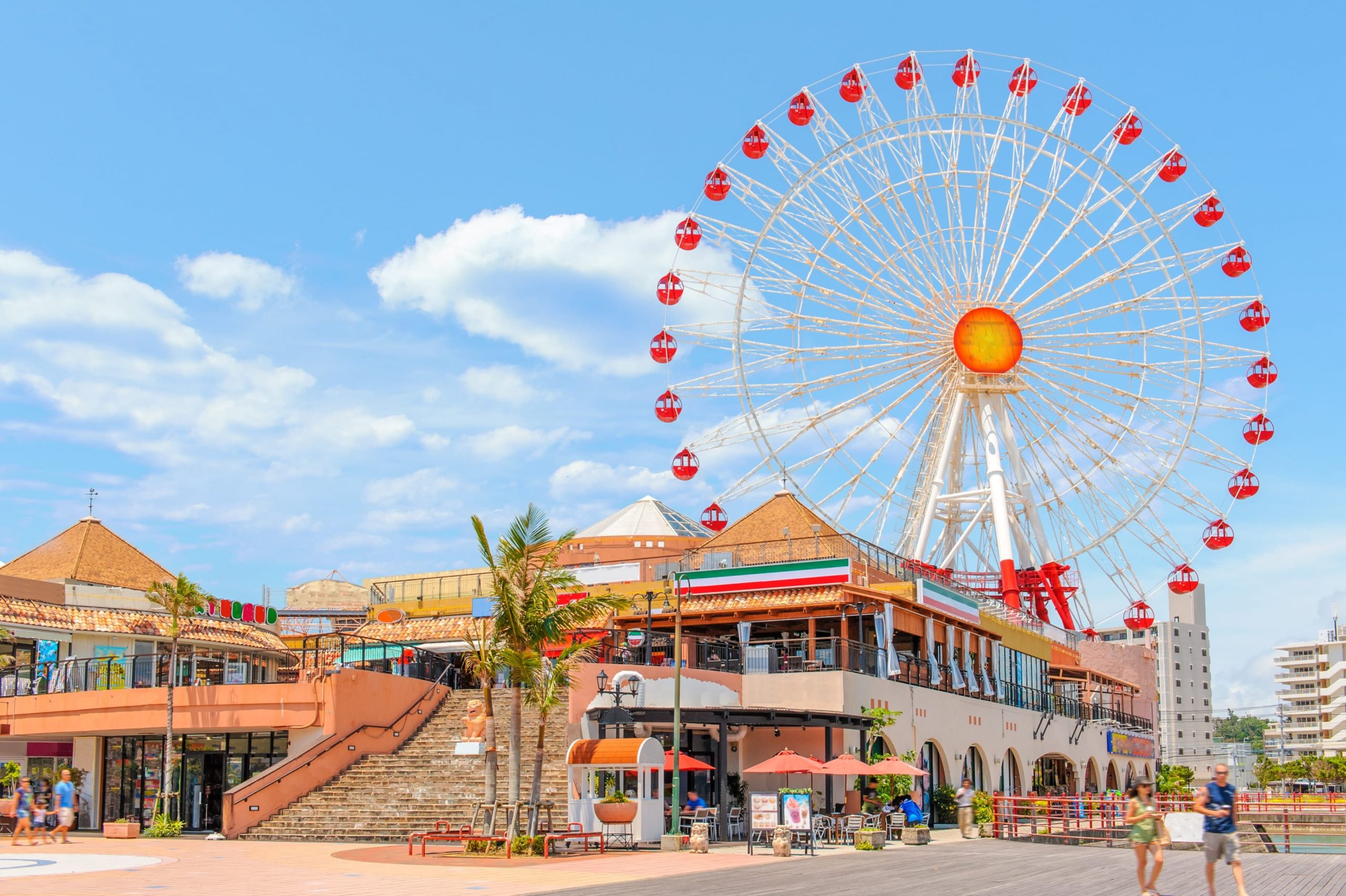
The complex includes a large Ferris wheel, a movie theater, a bowling alley, and live music venues.
For shopping enthusiasts, American Village offers numerous boutiques, international brands, and souvenir shops. The dining options span multiple cuisines, from Okinawan specialities to American comfort food to international restaurants. The complex’s waterfront location provides pleasant walking areas and sunset views with stunning vistas, making it a popular spot for evening entertainment during your Okinawa trip.
Practical Information:
- Located in Chatan, the central western coast of Okinawa
- Approximately 40 minutes from Naha by rental car
- Free admission; costs for shopping, dining, and activities
- Best visited in the late afternoon and evening
- Ample parking available
Kokusai Street: Naha’s Vibrant Shopping and Dining Hub
Kokusai Street serves as the main commercial artery through Naha city, stretching for approximately 1.6 kilometres through the heart of the capital. The street bustles with energy as locals and tourists browse the numerous souvenir shops, boutiques, restaurants, and bars lining both sides, making it one of the essential Okinawa experiences for shopping and dining. This is where you’ll find Okinawan specialities, awamori (traditional Okinawan spirits), Ryukyu glass, bingata textiles, and countless food products unique to the islands.
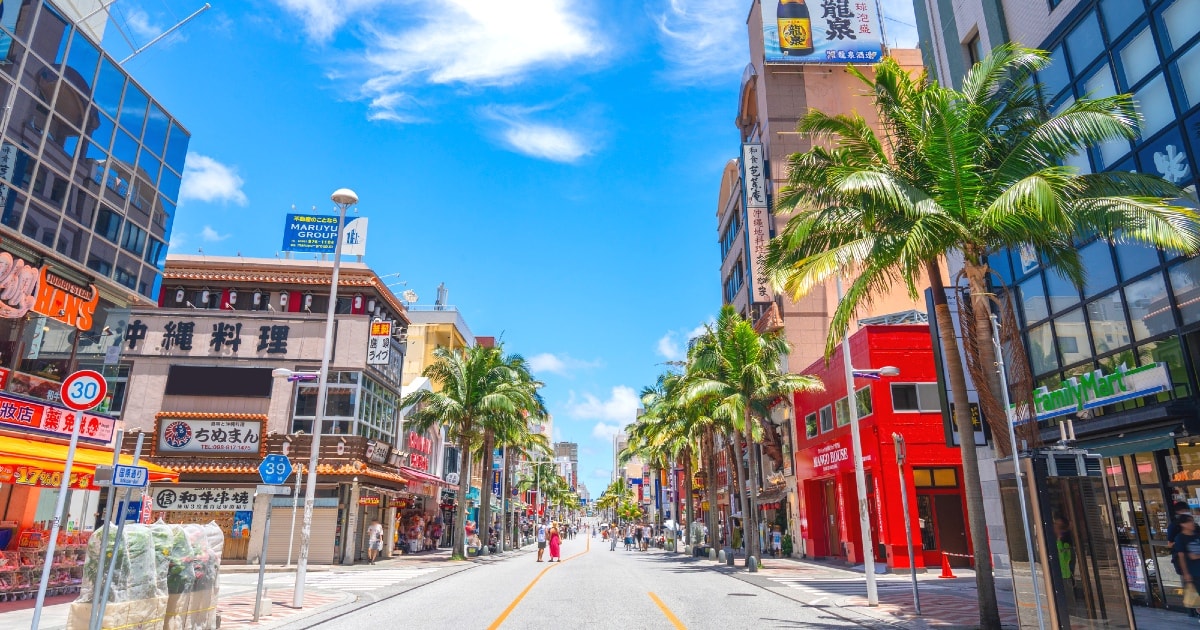
Kokusai Street and its side streets are full of restaurants offering local Okinawan cuisine.
Kokusai Street’s numerous restaurants and izakayas (Japanese-style pubs) provide opportunities to sample Okinawan cuisine, including Okinawa soba, taco rice, and dishes featuring bitter melon in casual settings. Side streets and covered arcades branching off Kokusai Street reveal additional shopping and dining options, rewarding exploratory wandering. The area’s proximity to Naha Airport makes it convenient for last-minute shopping or dining before departures.
Practical Information:
- Located in central Naha, accessible by monorail
- Closed to vehicle traffic on Sundays, creating a pedestrian-friendly environment
- Most shops open 10:00-21:00 or later
- Bargaining is generally not practised in established shops
- Can be crowded; visit during weekday mornings for a quieter experience
Nago Pineapple Park: Family-Friendly Fun
Nago Pineapple Park offers family-friendly entertainment and education about Okinawa’s pineapple cultivation history, making it one of the fun things to do in Okinawa for families with children. The park features automated carts that wind through pineapple fields and tropical gardens while providing information about pineapple growing and processing. Inside, exhibits showcase pineapple products, from fresh fruit to wines, juices, and desserts rich in vitamin C, with generous sampling opportunities.
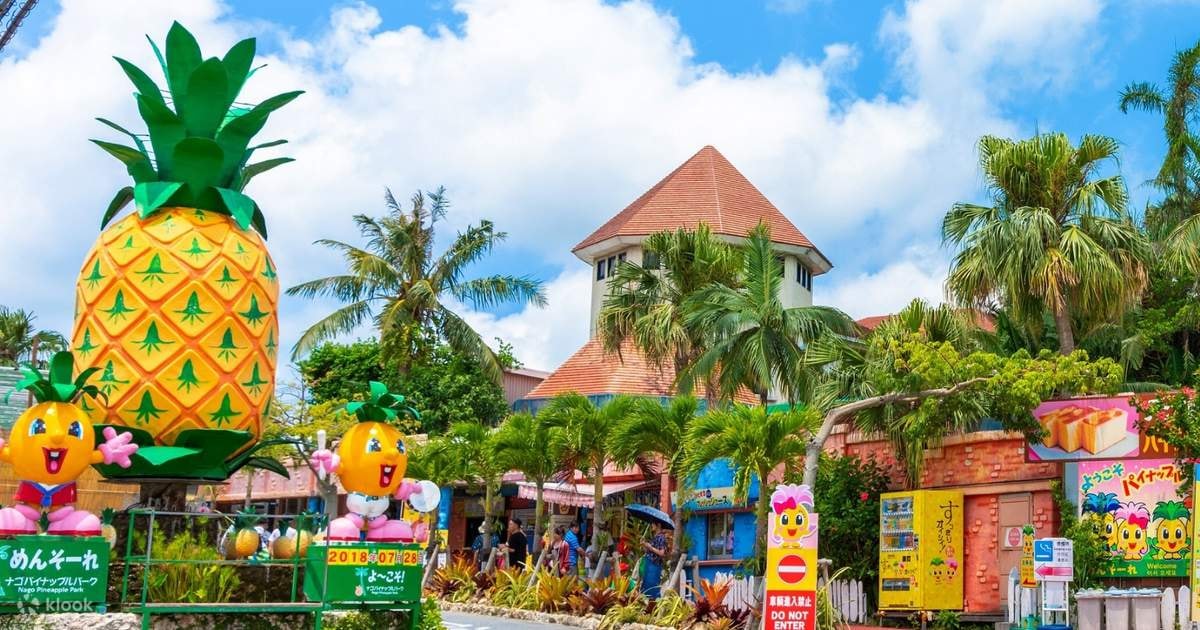
The park is filled with colorful pineapple statues and decorations.
While primarily aimed at families with children, the park’s tropical setting, quirky charm, and abundance of pineapple-flavoured treats can appeal to travellers of all ages seeking lighthearted entertainment during their Okinawa trip. The on-site shop offers numerous pineapple products as unique souvenirs.
Practical Information:
- Located in Nago, northern Okinawa
- Approximately 90 minutes from Naha by rental car
- Admission: Adults ¥1,200
- Allow 60-90 minutes for the visit
- Can be combined with visits to Churaumi Aquarium or northern attractions
Savouring Okinawan Cuisine
Okinawan cuisine stands distinctly apart from mainland Japanese food, reflecting the islands’ unique history, climate, and cultural influences. The traditional Okinawan diet has gained international attention for its association with the islands’ exceptional longevity. Okinawa boasts one of the world’s highest concentrations of centenarians. While modern dietary changes have affected these statistics, traditional Okinawan cuisine still emphasises fresh ingredients, abundant vegetables rich in vitamin C and other nutrients, and balanced nutrition that has sustained islanders for generations.
Signature Okinawan Dishes
Okinawa Soba represents one of the prefecture’s most beloved dishes and an essential part of experiencing Okinawan culture, though it differs significantly from mainland Japan soba. Despite the name, Okinawa soba uses wheat noodles rather than buckwheat, served in a rich broth typically flavoured with pork bone and kombu (kelp). Topped with tender stewed pork belly, fish cake, and green onions, a bowl of Okinawa soba provides comforting satisfaction and represents one of the must-try fun things to taste during your Okinawa trip. Numerous restaurants throughout the islands specialise in soba, each with subtle variations in broth and toppings that inspire fierce local loyalty.
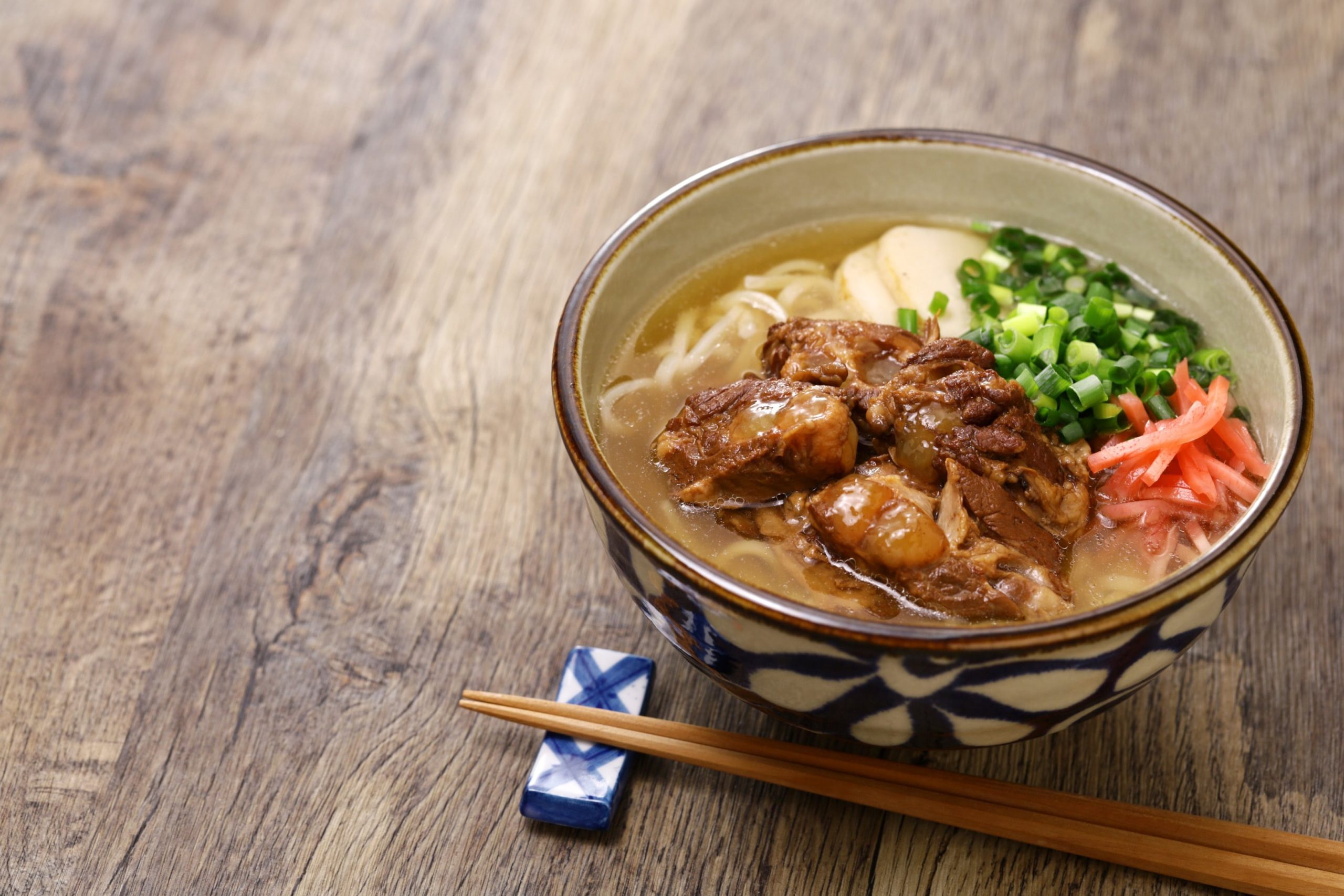
The noodles are made from wheat flour, not buckwheat, giving them a chewier texture.
Goya Champuru showcases bitter melon (goya), a vegetable prized in Okinawan cuisine for its health benefits despite its challenging flavour. This stir-fry combines bitter melon with tofu, egg, and pork, with soy sauce and other seasonings balancing the bitter notes. While the intense bitterness can be an acquired taste for visitors, goya champuru exemplifies Okinawan cooking’s emphasis on nutritious vegetables and balanced flavours. The bitter melon itself contains high levels of vitamin C and other nutrients, contributing to the traditional diet’s healthful reputation.
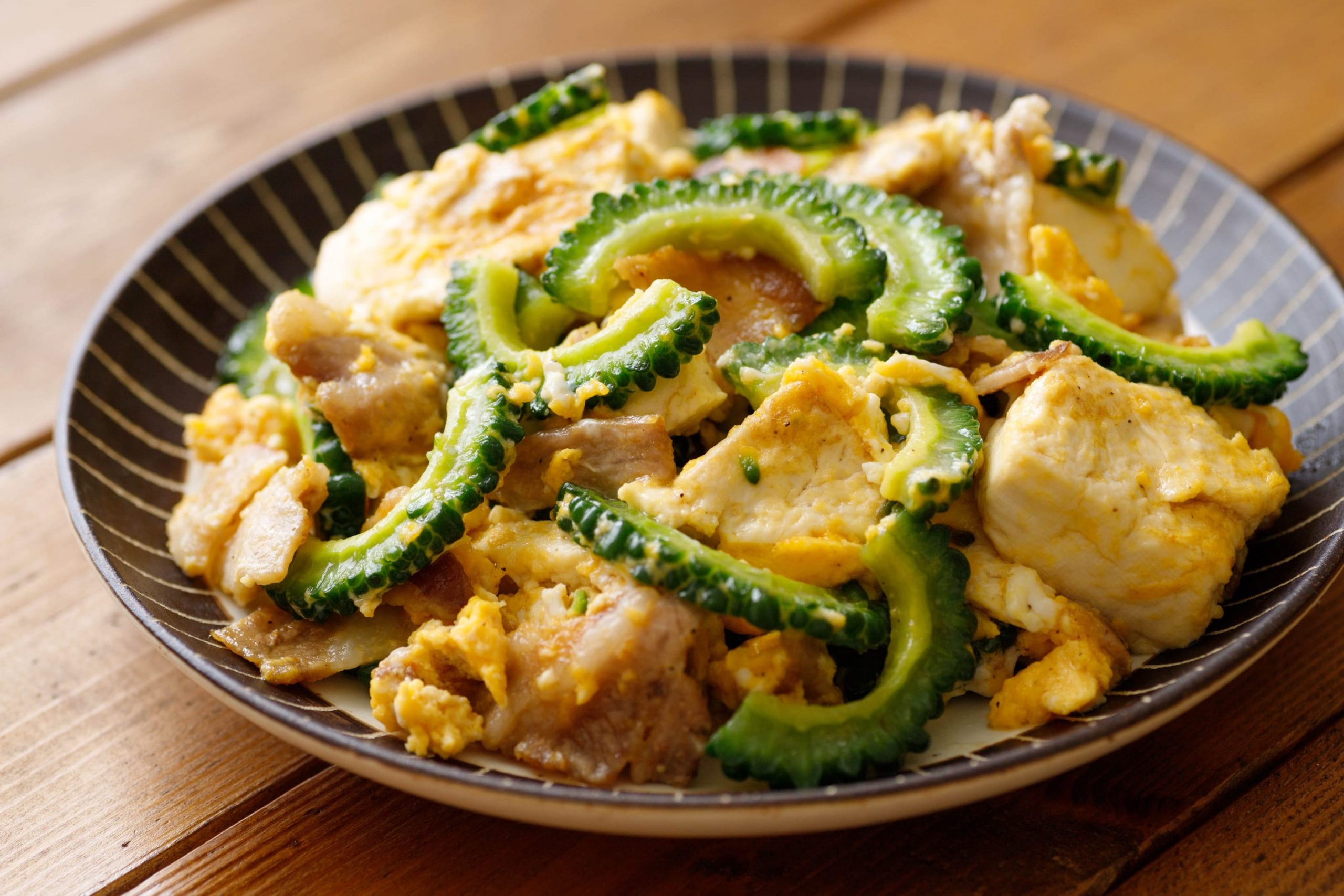
The name “champuru” means “to mix” or “stir-fry” in the Okinawan language.
Taco Rice demonstrates Okinawa’s unique fusion of cultures. This dish combines seasoned ground beef, lettuce, tomatoes, and cheese over white rice, essentially deconstructed tacos in bowl form. Created near American military bases and reflecting both Mexican-American and Japanese influences, taco rice has become thoroughly Okinawan, served everywhere from casual diners to izakayas. The dish’s popularity demonstrates how Okinawan culture absorbs outside influences while creating something distinctly local, making it one of the fun things to discover about Okinawa’s culinary evolution.
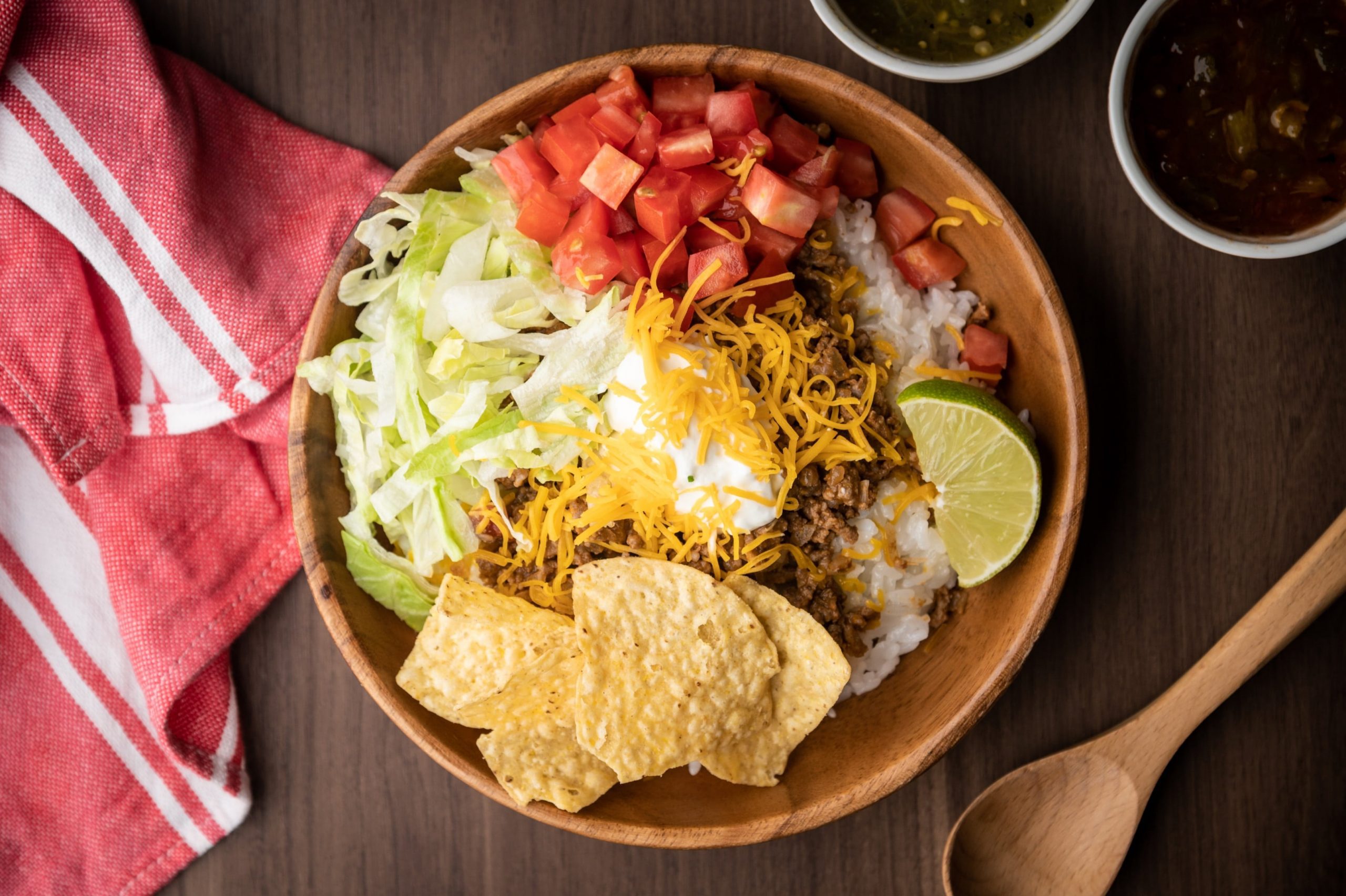
It is often served with salsa and a side of mayonnaise or sour cream.
Where to Experience Okinawan Cuisine
Throughout Naha city and across the islands, restaurants ranging from casual family-run establishments to upscale dining rooms showcase Okinawan cuisine. Kokusai Street and the surrounding areas in Naha offer dense concentrations of dining options, while each island and region has local favourites known for particular specialities, making exploring the food scene one of the most rewarding things to do in Okinawa.
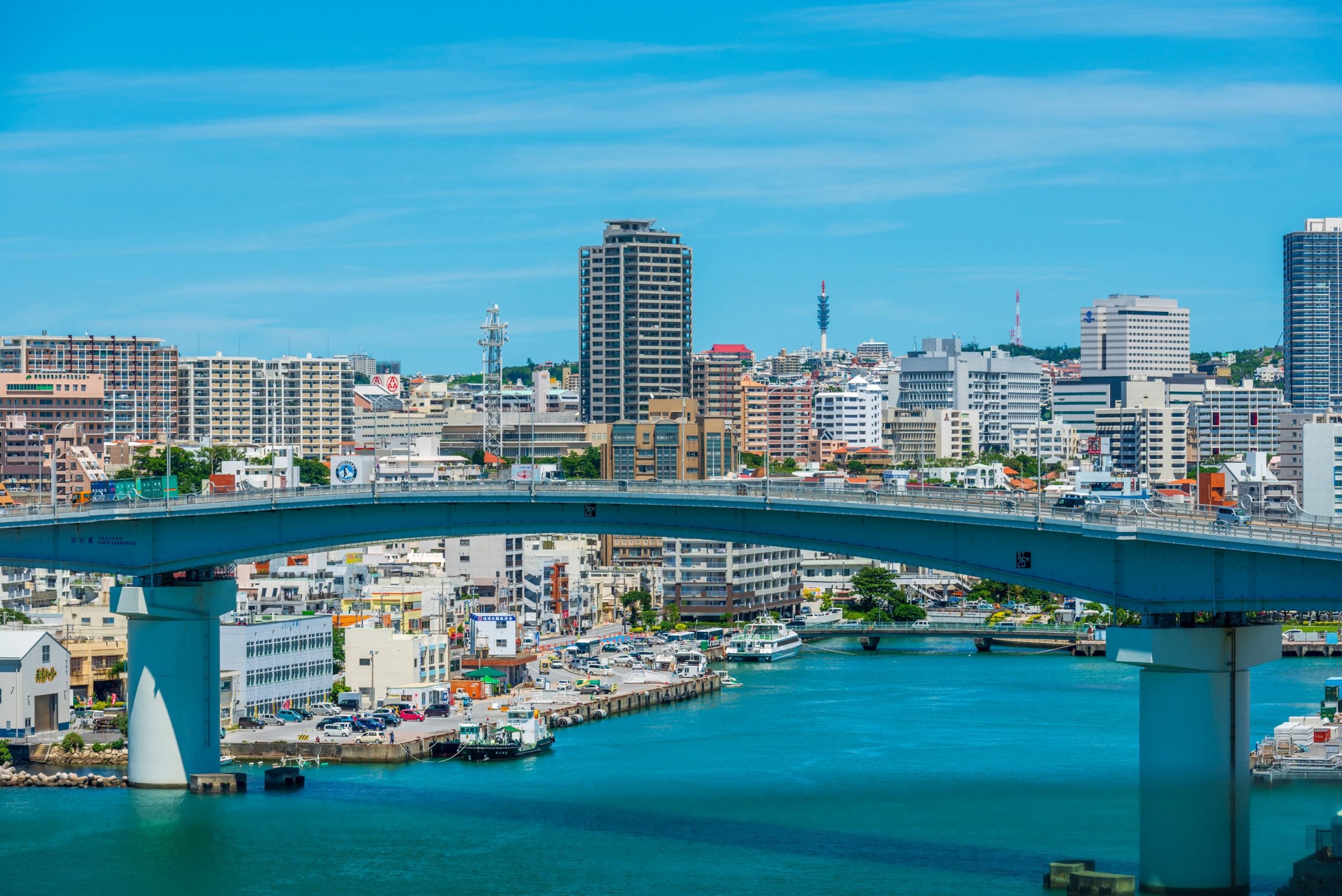
Naha is the main point of entry to Okinawa.
Many restaurants display plastic food models in their windows, allowing you to see what dishes like Okinawa soba, taco rice, and bitter melon preparations look like before ordering—a helpful feature when navigating unfamiliar cuisine. Staff at tourist attractions and tourist-oriented establishments often speak some English and can guide you toward popular or representative dishes. For adventurous eaters, seeking out local favourites away from main tourist areas often yields memorable meals and insights into contemporary Okinawan food culture.
While we haven’t personally stayed at every property or dined at every restaurant across the islands, the establishments mentioned throughout this guide represent well-regarded options that many visitors have enjoyed. Your own discoveries will add to your unique Okinawa experience.
Practical Information:
- Most restaurants accept cash, and are increasingly accepting cards in tourist areas
- Typical meal costs: Casual lunch ¥800-1,500, Dinner ¥1,500-3,000, Upscale dining ¥5,000+
- Many restaurants close between lunch and dinner service (roughly 15:00-17:00)
- Tipping is not practised in Japan
- Some traditional establishments have limited English; translation apps can help
Best Times to Visit Okinawa
Okinawa’s subtropical climate creates distinct seasons that affect travel experiences significantly when visiting Okinawa:
Summer (June-September): The warmest months offer perfect beach weather with water temperatures ideal for swimming and water sports—prime time for enjoying crystal clear waters and scuba diving. However, this is also typhoon season, with potential for storms disrupting travel plans, and the peak tourist season when many visitors crowd popular tourist attractions. Summer’s heat and humidity can be intense—temperatures regularly exceed 30°C with high humidity—though the beaches and ocean provide welcome relief.
Autumn (October-November): Many consider these the ideal months for visiting Okinawa. Weather remains warm enough for swimming in crystal clear waters, rainfall decreases, typhoon risk diminishes, and crowds thin as the Japanese summer vacation ends. The pleasant conditions and fewer visitors create optimal experiences at beaches and tourist attractions, while the starry sky becomes particularly clear on cool autumn nights. This represents perhaps the best time for the Okinawa trip if flexibility allows.
Winter (December-March): Winter in Okinawa means mild temperatures (15-20°C), but the water is too cool for comfortable swimming without wetsuits. However, whale watching opportunities emerge as humpback whales migrate through Okinawan waters—offering unique outdoor activities for winter visitors. Winter offers the quietest tourist season, with significantly lower accommodation costs and uncrowded attractions, making it ideal for those prioritising cultural experiences and exploring Okinawan culture over beach activities.
Spring (April-May): Spring brings warming temperatures, blooming flowers, and increasingly comfortable water temperatures, making it a great time to enjoy the beautiful islands. The season avoids both summer crowds and the rainy season that begins in late May/early June. This represents another excellent time for visiting, particularly for those who prioritise pleasant weather and moderate crowds while exploring Okinawa attractions.
F.A.Qs
What is Okinawa popular for?
Okinawa is famous for its tropical beaches, coral reefs and marine life, Ryukyu culture and heritage, traditional crafts such as bingata textiles and pottery, and the origins of karate.
How many days in Okinawa are enough?
A 3-day stay covers the highlights, but 5–7 days is more comfortable for exploring beaches, nature, and islands without rushing.
What can you do in Okinawa, Japan?
Enjoy snorkelling/diving, visit Okinawa Churaumi Aquarium, explore Shuri Castle and Ryukyu ruins, try local cuisine, make shisa pottery, walk in subtropical forests, and island-hop.
Is it worth visiting Okinawa when in Japan?
Yes — it offers a very different vibe from mainland Japan: tropical scenery, unique culture, and relaxation. For travellers who want both cities and nature, Okinawa offers a refreshing contrast.
Your Okinawa Adventure Awaits
From the moment you arrive at Naha Airport to your final sunset over crystal clear waters, visiting Okinawa offers transformative experiences that blend cultural richness, natural beauty, and warm hospitality. Whether you’re exploring the historical legacy of Shuri Castle and the Ryukyu kings, diving with whale sharks at the Churaumi Aquarium, swimming alongside sea turtles in the Kerama Islands, or savouring authentic Okinawa soba and taco rice flavoured with local soy sauce, every moment reveals another facet of these remarkable islands.
The Okinawa main island provides an excellent introduction, with Naha city’s urban energy, accessible tourist attractions, and the gateway to both cultural sites and natural wonders. But venturing to the outlying islands—Miyako Island’s pristine beaches, the adventure of exploring Ishigaki and Iriomote Islands, the traditional charm of Taketomi Island, or the diving paradise of Tokashiki Island in the Kerama Islands—reveals the true diversity and magic of Okinawa. Each island offers distinct character and experiences, ensuring your Okinawa trip encompasses both variety and depth.
Visit Japan in another place? Check out our guide for your best travel inspiration.
